Sunoh Kim
Enhancing Weakly Supervised Video Grounding via Diverse Inference Strategies for Boundary and Prediction Selection
Mar 29, 2025Abstract:Weakly supervised video grounding aims to localize temporal boundaries relevant to a given query without explicit ground-truth temporal boundaries. While existing methods primarily use Gaussian-based proposals, they overlook the importance of (1) boundary prediction and (2) top-1 prediction selection during inference. In their boundary prediction, boundaries are simply set at half a standard deviation away from a Gaussian mean on both sides, which may not accurately capture the optimal boundaries. In the top-1 prediction process, these existing methods rely heavily on intersections with other proposals, without considering the varying quality of each proposal. To address these issues, we explore various inference strategies by introducing (1) novel boundary prediction methods to capture diverse boundaries from multiple Gaussians and (2) new selection methods that take proposal quality into account. Extensive experiments on the ActivityNet Captions and Charades-STA datasets validate the effectiveness of our inference strategies, demonstrating performance improvements without requiring additional training.
Gaussian Mixture Proposals with Pull-Push Learning Scheme to Capture Diverse Events for Weakly Supervised Temporal Video Grounding
Dec 27, 2023Abstract:In the weakly supervised temporal video grounding study, previous methods use predetermined single Gaussian proposals which lack the ability to express diverse events described by the sentence query. To enhance the expression ability of a proposal, we propose a Gaussian mixture proposal (GMP) that can depict arbitrary shapes by learning importance, centroid, and range of every Gaussian in the mixture. In learning GMP, each Gaussian is not trained in a feature space but is implemented over a temporal location. Thus the conventional feature-based learning for Gaussian mixture model is not valid for our case. In our special setting, to learn moderately coupled Gaussian mixture capturing diverse events, we newly propose a pull-push learning scheme using pulling and pushing losses, each of which plays an opposite role to the other. The effects of components in our scheme are verified in-depth with extensive ablation studies and the overall scheme achieves state-of-the-art performance. Our code is available at https://github.com/sunoh-kim/pps.
Position-aware Location Regression Network for Temporal Video Grounding
Apr 12, 2022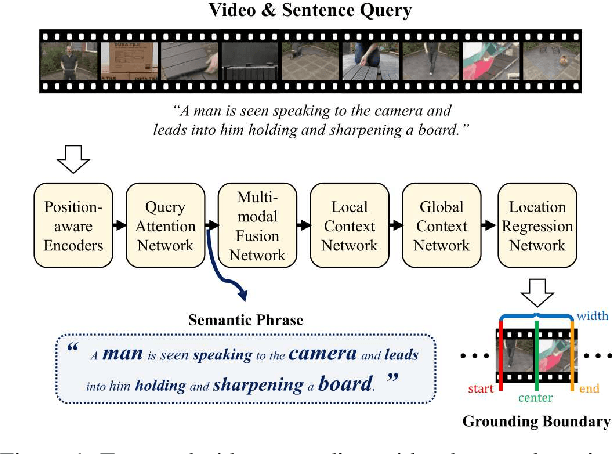

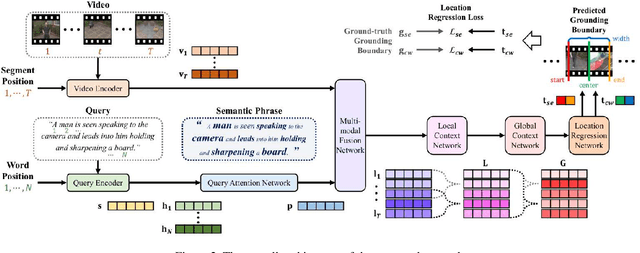
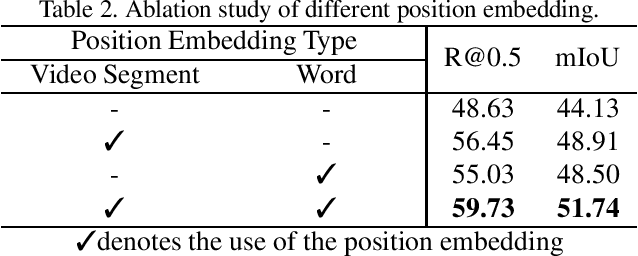
Abstract:The key to successful grounding for video surveillance is to understand a semantic phrase corresponding to important actors and objects. Conventional methods ignore comprehensive contexts for the phrase or require heavy computation for multiple phrases. To understand comprehensive contexts with only one semantic phrase, we propose Position-aware Location Regression Network (PLRN) which exploits position-aware features of a query and a video. Specifically, PLRN first encodes both the video and query using positional information of words and video segments. Then, a semantic phrase feature is extracted from an encoded query with attention. The semantic phrase feature and encoded video are merged and made into a context-aware feature by reflecting local and global contexts. Finally, PLRN predicts start, end, center, and width values of a grounding boundary. Our experiments show that PLRN achieves competitive performance over existing methods with less computation time and memory.
Skeleton-based Action Recognition of People Handling Objects
Jan 21, 2019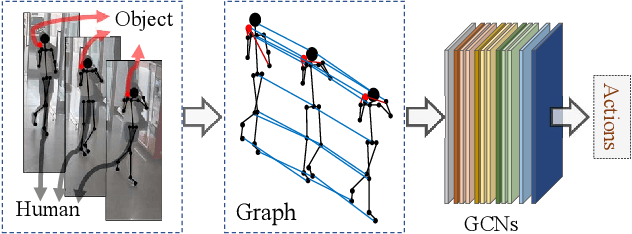


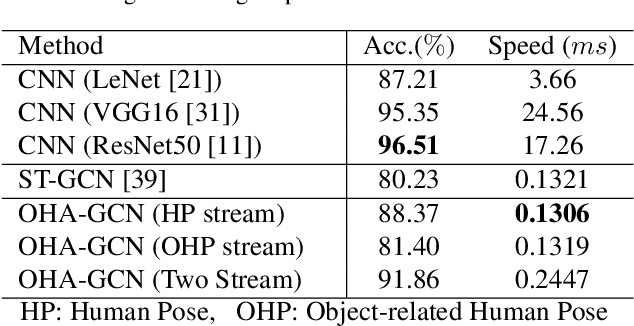
Abstract:In visual surveillance systems, it is necessary to recognize the behavior of people handling objects such as a phone, a cup, or a plastic bag. In this paper, to address this problem, we propose a new framework for recognizing object-related human actions by graph convolutional networks using human and object poses. In this framework, we construct skeletal graphs of reliable human poses by selectively sampling the informative frames in a video, which include human joints with high confidence scores obtained in pose estimation. The skeletal graphs generated from the sampled frames represent human poses related to the object position in both the spatial and temporal domains, and these graphs are used as inputs to the graph convolutional networks. Through experiments over an open benchmark and our own data sets, we verify the validity of our framework in that our method outperforms the state-of-the-art method for skeleton-based action recognition.
 Add to Chrome
Add to Chrome Add to Firefox
Add to Firefox Add to Edge
Add to Edge